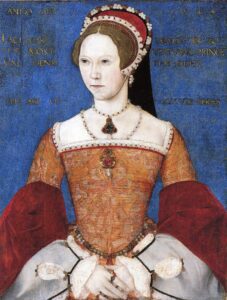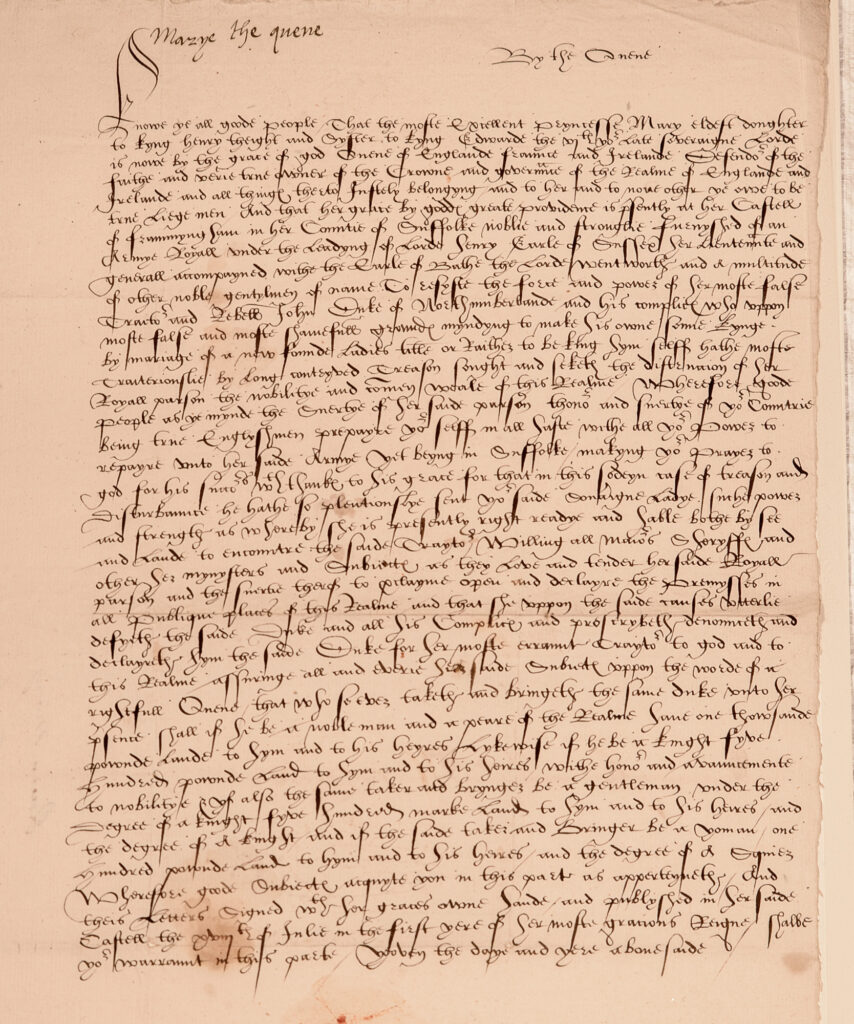
The Lanman Museum has a copy of a document, shown below, written by Mary Tudor in Framlingham Castle on the day before she was proclaimed Queen of England.
The days before Mary Tudor became Queen Mary were tumultuous for England, and for Framlingham.
Henry VIII’s only son Edward VI had just died on 6th July 1553 at the age of 15. Who would succeed him? Mary Tudor was next in line, but many of the nobility feared (rightly) that Mary would undo the Reformation and return England to Catholicism. This group, led by John Dudley, Duke of Northumberland, wanted Lady Jane Grey to succeed and maintain England as a Protestant country. Lady Jane Grey was proclaimed Queen on 10th July by Northumberland and his supporters, and Mary Tudor fled to East Anglia.
But by 12th July, Mary and her supporters had assembled a military force here at Framlingham Castle. Northumberland’s support collapsed, and he and Lady Jane Grey were imprisoned in the Tower of London. Mary was proclaimed Queen on 19th July. Mary rode triumphantly into London on 3rd August 1553, on a wave of popular support.

On the day before Mary was proclaimed Queen, she wrote this document in Framlingham Castle. It is the first known reference to Mary as Queen. The original is owned by Sir Henry Edgar Paston-Bedingfeld, 10th Baronet of Oxburgh and is on display at Oxburgh Hall, Norfolk, and a copy is held in the Lanman Museum and shown below.
This is a very important document. It’s the first thing we have written by Mary Tudor that she has signed as Queen. It is written when she was in Framlingham Castle. Mary is telling people in no uncertain terms that she is the Queen.
This document is critical to the story. She is telling everyone that she is Queen and has a big army led by Henry Radclyffe (1507-1557), Earl of Sussex. He was Mary’s second cousin and is related to the Howard Family who are buried in Framlingham Church. Mary also mentions John Bouchier (1499- 1560/1) the 2nd Earl of Bath. He was one of Mary’s most loyal supporters and became a commissioner at the trial of Lady Jane Grey. She finally mentions Thomas Wentworth (1525-1584), the 2nd Baron Wentworth. In June 1553 he signed the Letters Patent intended to favour Lady Jane Grey but by the time this is written a month later he had changed to support Mary.
Queen Mary is clearly very angry with the ‘moste False’ traitor John Dudley (1504-1553), 1st Duke of Northumberland. Before the death of Mary’s brother King Edward VI, Dudley had been in charge of the Government from 1550 to 1553. It was he who temporarily installed Lady Jane Grey on the English throne in line with Edward VI’s second will. Lady Jane Grey was John Dudley’s daughter-in-law. Historians still debate if John Dudley was trying to get his family to be rulers of England or genuinely trying to fulfil the last wish of his master, the 15 year old Edward VI. He was tried of High Treason exactly one month after this document was written on 18th August 1553, found guilty and executed on the 22nd August.
At the time Mary wrote this, she didn’t know if she would win what looked like being a difficult civil war. She commands all her subjects to find and capture John Dudley and offers very detailed rewards for doing so: noblemen and Lords get £1,000, which was a lot of money then; Knights get £500 pounds; gentleman would be Knighted and also would get 500 marks (a type of coin then); and yeoman (farm owners) would get £100 and a promotion to Squire (which was the rank below Knight).
Below the document is a transcription in more readable form.

Marye the queen
By the Quene
Knowe ye all goode People That the moste Excellent Pryncesse Mary eldest doughter to king henry theight [1] and Syster to kyng Edwarde the vjth yo[ur] late Soveraigne Lorde is nowe by the grace of god Quene of Englande Frannce and Irelande Defendo[ur] of the Faithe and verie true owner of the Crowne and govern[a]nce of the Realme of Englande and Irelande and all thing[es] therto Justely belongyng and to her and to none other ye owe to be true Liege men And that her grace by godd[es] greate providence is p[re]sently at her Castell of Frammyngham in her Countie of Suffolke noblie and stronglie Furnyshed of an Armye Royall under the leadyng of lorde Henry Earle of Sussex her lieuten[a]nte and generall accompayned withe the Earle of Bathe the Lorde Wentworth and a multitude of other noble gentylmen of name To resyste the force and power of her moste False Traito[ur] and Rebell John Duke of Northumberlande and his complic[es] who upon moste false and moste shamefull ground[es] myndyng to make his owne sonne kynge by mariage of a new founde ladies title or Raither to be king hym selff hathe moste Traiteriouslie by long conteyved [2] Treason sought and seketh the distruccion of her Royall parson [3] the nobilitye and com[m]en weale of this Realme Wherefore goode People as ye mynde the Suertye [4] of her saide parson thono[ur] [5] and suertye of yo[ur] Countrie being true Englyshmen prepayre yo[ur] selff in all haste withe all yo[ur] Power to repayre unto her saide Armye yet beyng in Suffolke makyng yo[ur] Prayer to god for his succo[ur]s w[i]th thank[es] to his grace for that in this sodeyn case of treason and Disturbannce he hathe so plentiouslye sent yo[ur] saide Sov[er]aigne Ladye suche power and strength as whereby she is presently right readye and hable [6] bothe by see and Lande to encountre the saide Trayto[ur] Willing all Maio[ur]s Sheryff[es] and other her mynysters and Subiect[es] as they Love and tender her saide Royall parson and the suertie therof to p[ro]clayme open and declayre the Premysses in all Publique places of this Realme and that she uppon the said causes utterlie defyeth the saide Duke and all his Complic[es] and proscrybeth denounceth and declayreth hym the saide Duke for her moste errannt Trayto[ur] to god and to this Realme assuringe all and everie her saide Subiect[es] uppon the worde of a rightfull Quene that who soever taketh and bringeth the same duke unto her p[re]sence shall if he be a noble man and a peare of the Realme have one thowsande pownde Lande to hym and to his heyres Lykewise if he be a knight fyve Hundred pownde Land to hym and to his heires withe hono[ur] and avanncemente to nobilitye & yf [7] also the same taker and brynger be a gentleman under the Degree of a knight fyve hundred marke Land to hym and to his heires and the degree of A knight and if the saide taker and Bringer be a yoman one Hundred pownde Land to hym and to his heires and the degree of a Squier Wherefore good Subiect[es] acquyte you in this part as apperteyneth And theis Letters Signed w[i]th her graces owne hande and publyshed in her saide Castell the xviijth of Julie in the first yere of her moste gracious Reigne [8] shalbe yo[ur] warrannt in this parte Yeoven [9] the daye and yere abovesaide
Notes
1 the and eighth are run together to form theight
2 conceived
3 person not parson
4 surety
5 the honour
6 able
7 if
8 18th July 1553
9 Given
Transcription by Judy Lester at Kerrywood Research
